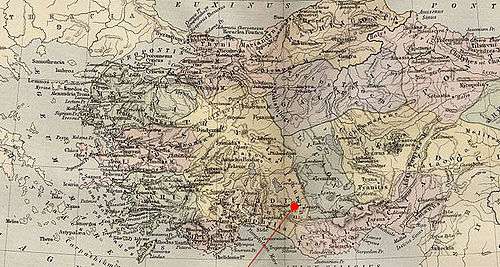Isaura Palaea

Isaura Palaea (Greek: Ἴσαυρα Παλαιά, Isaura Palaia, "Old Isaura") or Leontopolis (Λεοντόπολις, "city of Leo") was a Roman and Byzantine era town in southern Turkey.[1] The city has been identified with modern Zengibar Kalesi near Konya.[2]
In antiquity the city was in Isauria (Ἰσαυρία) district[3] of Lycaonia in today's southern Turkey.
History
_p469_PLAN_OF_THE_RUINES_OF_THE_CITY_OF_ISAURA.jpg)
Before the Romans the town was a strongly fortified city of the Isaurians, located at the foot of Mt. Taurus. It was besieged by Perdiccas, the Macedonian regent after Alexander the Great's death, the Isaurians set the place alight and let it perish in flames rather than submit to capture.[4]
The area was conquered by the Romans in 75 BC. From 492-496 AD the area was fought over between emperor Anastasius I and the local rebels, in what was to become known as the Isaurian War.
The Seljuq Turks manage to take control of the area in the late 11th century, after the Battle of Manzikert.
Bishopric
The city was the seat of an ancient bishopric and is mentioned in all the Notitiae Episcopatuum of the Byzantine era.[5] In the mid Byzantine period the city bishopric was merged with the older neighbouring bishopric of Isauropolis.
The Isaurian church was originally under the authority of the Patriarch of Antioch, but was attached to the Patriarch of Constantinople in the late 7th or early 8th century.[6]
Epitaphs have been found of three bishops, Theophilus, Sisamoas, and Mamas, who lived between the years 250 and 400. Three other bishops are also known, Hilarius, 381; Callistratus, somewhat later; Aetius, 451.[7] The last named bishop also bears the title of Isauropolis, the name of a city which also figures in the Hierocles's Synecdemus.[8] As no Notitiae Episcopatuum make mention of Isauropolis, Ramsay supposes that the Diocese of Isauropolis was early joined with that of Isaura Palaea which is mentioned in all the Notitiae.
The bishopric remains a titular see of the Roman Catholic church.[9]
References
- ↑ Rogers, Clifford (June 2010). The Oxford Encyclopedia of Medieval Warfare and Military Technology, Volume 1 . Oxford University Press. p. 42.
- ↑ Tomaschitz, Kurt, "Isauria, Isauri", Brill’s New Pauly, retrieved 10 July 2016
- ↑ W. M. Ramsay, The Historical Geography of Asia Minor (2010) p395].
- ↑ Rogers, Clifford (June 2010). The Oxford Encyclopedia of Medieval Warfare and Military Technology, Volume 1. Oxford University Press. p. 42. ISBN 0-1953-3403-5.
- ↑ W. M. Ramsay, The Historical Geography of Asia Minor (2010) p429.
- ↑ Glen Bowersock, Peter Brown, Oleg Grabar, Late Antiquity: A Guide to the Postclassical World, s.v. Isauria, p. 515.
- ↑ Lequien, "Oriens christ.", I, 1085
- ↑ ed. Parthey, 675, 12
- ↑ Annuario Pontificio 2013 (Libreria Editrice Vaticana, 2013).